Learn Everything About Growing Pansies in pots and gardens for a colorful display of viola blooms in your small garden.
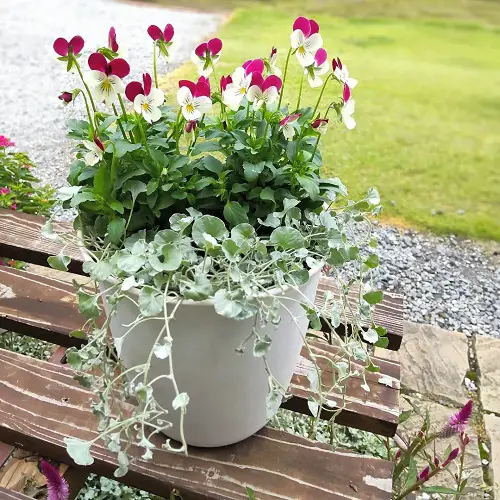
If you want stunning flowers to grace your home garden, then read our guide on Everything About Growing Pansies below!
Read about the Pansy Flower Meaning and What it Symbolizes
What About Pansies?
Pansies, or Violets, are unique smiling face annual flowers that are perfect for flower beds and containers. They are super easy to grow and are available in a wide range of colors, including purple, yellow, white, and pink.
They have this cute face-like pattern on their petals, with a black dot at the center, which makes them look human-like and a real favorite of kids. What’s more amazing is these flowers also attract many pollinators like bees, butterflies, and hummingbirds.
As pansies prefer cooler temperatures, they are best grown in areas that don’t get too hot during the summer. While pansies go well with any other annual with similar growing requirements, you can plant them with cool-season blooms like primroses, viola, sweet alyssum, and trailing lobelia.
Find out: Are Pansies Edible?
Some of Our Favorite Pansies
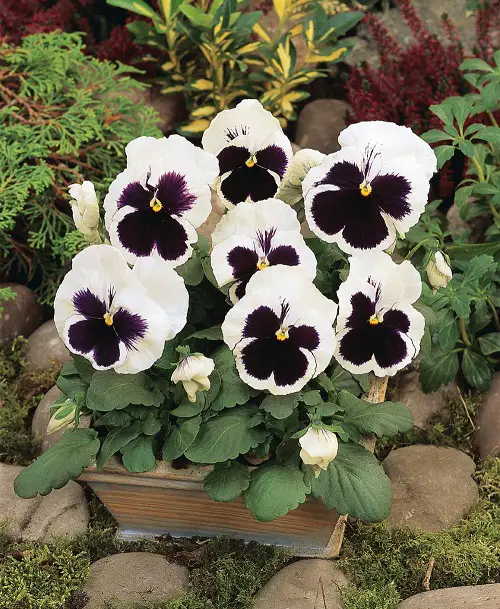
- Pansy ‘Ultima Morpho’ features purple blooms with a yellow, black striped center on compact plants.
- Pansy ‘Tiger Eyes’ produces gold blooms; each petal is patterned with thin black streaks, hence the name. This hardy variety can be grown from seeds.
- Pansy ‘Cat’s Whiskers’ displays large, showy blossoms veined patterns similar to cat whiskers in a range of shades.
- Pansy ‘Adonis’ bears large blue flowers with a dark blue center over a white background from May to September.
- Pansy ‘Universal Series’ offers orange, blue, red, yellow, white, and purple blossoms.
- Pansy ‘Freefall Lavender’ is a member of the ‘Freefall’ series; it comes in many shades. This trailing pansy has a robust spreading habit.
- ‘Fama Series’ blooms in winter and spring; they display single and mixed-color blooms.
- ‘Jolly Joker’ flowers in spring and summer. It showcases orange blossoms with deep purple upper petals with a purple outline.
- ‘Princess Series’ exhibits blooms in various shades of purple, blue, and yellow.
Here are the best varieties of pansies you must grow
When to Plant Pansies?
Pansies are a cool-season annual, so the best time to plant them depends on your location. In most parts of the US, the ideal planting time for pansies is in the late fall, from September through November. This allows the roots to become established before cold weather sets in. In the South (preferably USDA Zones 9 to 11) and other warmer climates around the world, pansies can also be planted in winter and spring.
Check Best Plants For Hanging Baskets
Propagating Pansies
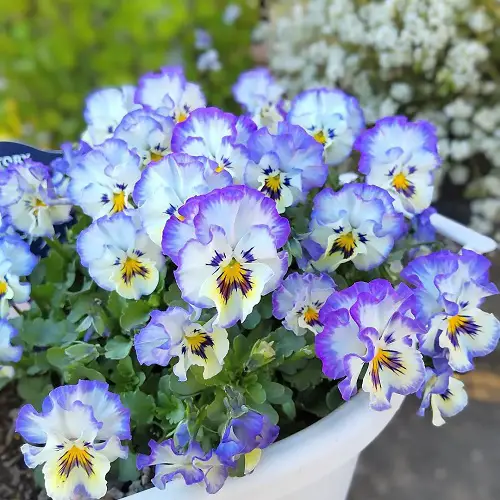
From Cuttings
One of the best ways to propagate pansies is by taking stem cuttings. Take a cutting that is approximately 4-5 inches long and remove the lower leaves. Dip the cutting end in the rooting hormone and plant it in moist potting soil.
Cover the pot with a plastic bag or glass jar and place it in a warm, bright area. After a few weeks, you should see roots beginning to form. Once the roots are established, you can transplant them into a pot or directly into the garden.
From Seeds
Sow the seeds in moist potting soil in the spring. Place the pot in a warm, sunny location and moisten the soil. Germination usually takes about two weeks. Once the seedlings have grown a few sets of true leaves, you can transplant them into a pot or directly into the garden.
By Division
Pansies are also easy to divide. Dig up the entire plant and gently separate the roots into several sections. Replant the sections in a pot or directly into the garden. Water the plants regularly.
Or, if you’re a small space gardener–buy a few pansy transplants from a nearby nursery and plant them in desired containers.
Check out Indoor Plants With Purple Flowers
Best Container Size for Pansies
The best container size for pansies depends on the number of plants you want to grow. If you plan to grow a single plant, a pot that is 6-8 inches in diameter is ideal.
For two to three plants, a pot that is 8-10 inches in diameter is recommended. If you plan to grow four to six plants, a pot that is 10-12 inches is best.
Requirements for Growing Pansies
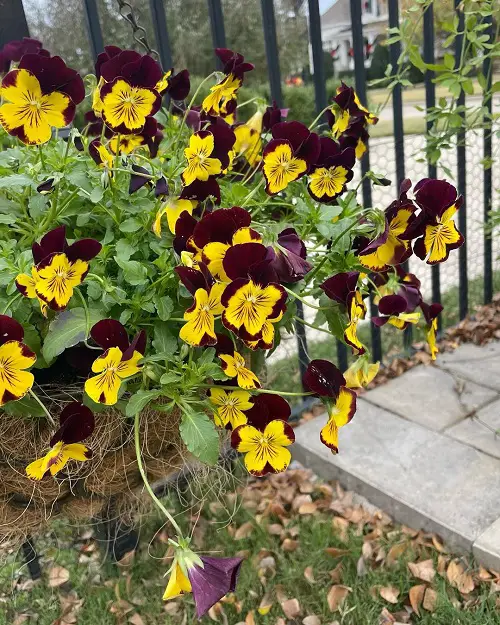
Location
Pansies prefer cool temperatures and grow best in partial shade or full sun. They require at least 5 hours of direct sunlight each day. This plant can tolerate full sun, but if the light is too strong (in hot regions), the flowers may suffer from sunburn or wilting.
Keep the pots near a south-facing patio during early spring or fall. In the summer, place the plants on the east side of your home for morning sunlight and afternoon shade.
Soil
Pansy flowers do best in well-draining, nutrient-rich potting soil. The soil should be light and airy, with a slightly acidic to neutral pH of 6.0 to 7.0. A good soilless potting mix can be made by combining equal parts of peat moss, perlite, and vermiculite.
Compost or aged manure can also be added to increase nutrient content. Or, you can DIY using half of the garden soil and half of the aged manure. To make it even better, add some coarse sand, coconut coir, or peat moss.
Water
Pansies require minimal watering. They are best watered when the top inch of soil has dried out. When watering pansies, it is important to water deeply to reach the root zone. This helps to encourage a deep, strong root system and prevent root rot.
Avoid over-watering, as this can cause root rot, stunted growth, and other problems. If you live in a hot climate, pansies may require more frequent watering.
Temperature
Pansy flowers thrive in temperatures between 40-80°F (4-25°C). When nighttime temperatures are consistently below 40°F (4°C), pansy flowers will not grow well.
Discover Pansy Flower Tattoo Meaning and Ideas
Pansies Care
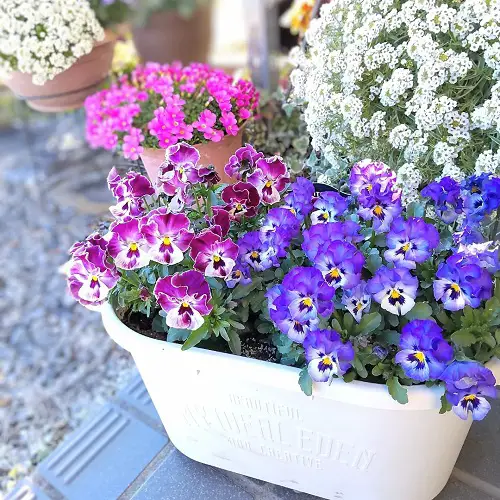
Fertilizer
Pansies are easy to care for and require minimal fertilization. When fertilizing pansies, use a slow-release fertilizer specifically made for flowering plants.
A 10-10-10 ratio is ideal. Apply fertilizer to the soil surrounding the pansies once in 7-8 weeks, in the spring and again in the fall.
Be careful not to over-fertilize, as this can be harmful to the plant. A light application of fertilizer every few weeks is all that is necessary.
Deadheading
Deadheading pansy flowers is the process of removing spent flowers from the plant. This helps encourage the growth of more flowers and keeps the plant looking neat and tidy.
To deadhead pansy flowers, simply pinch or snip off the flower head at the base of the stem. If the stem is tough, use a pair of sharp scissors or pruning shears.
Be sure to remove only the flower and not the foliage, as this could damage the plant.
Overwintering
To overwinter pansy flowers, you must protect them from extremely cold temperatures. Mulch with straw, leaves, or pine needles around the base of the plants.
If temperatures are expected to drop below 0°C, you can cover the plants with a layer of burlap or other protective material. Water the plants regularly during the winter months to keep the soil slightly moist.
When temperatures start to warm up in the spring, the plants will start to produce new blooms.
Pests and Diseases
Pests:
1. Aphids: Small insects that suck the sap from the leaves or stems of pansies, causing them to become distorted or discolored.
2. Slugs and Snails: These pests feed on the leaves and flowers of pansies, leaving behind holes and slime trails.
3. Japanese Beetles: These beetles feed on the leaves of pansies, leaving behind skeletonized foliage.
4. Spider Mites: These tiny pests feed on the stems and leaves of pansies, causing them to turn yellow and drop off.
Diseases:
1. Powdery Mildew: This fungal disease causes white, powdery spots on the leaves and stems of pansies.
2. Leaf Spot: This fungal disease causes spots on the leaves of pansies, which can eventually cause the leaves to turn yellow and drop off.
3. Southern Blight: This fungal disease causes the stems and leaves of pansies to rot and die.
4. Stem Rot: This fungal disease causes the stems and leaves of pansies to rot, causing them to wilt and die.
Most of these diseases are caused by lack of sunlight and overwatering.
Check out Edible Blooms for Nutritional Benefits
How to Get Pansies to Bloom
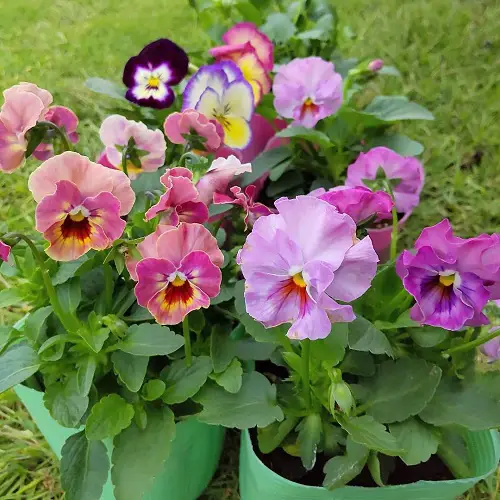
1. Provide plenty of sunlight. Pansies need at least six hours of direct sunlight each day in order to bloom.
2. Plant them in well-draining soil. Pansies need soil that drains well, as they are susceptible to root rot if it is too wet.
3. Fertilize regularly. Pansies need regular fertilizing in order to bloom and remain healthy. Use a balanced fertilizer, such as a 10-10-10, every 7-8 weeks.
4. Deadhead spent blooms. Remove the spent blooms to encourage new blooms to form.
5. Water thoroughly. Water your pansies deeply and regularly, allowing the soil to dry slightly between waterings.
6. Keep soil temperature consistent. Pansies will not bloom if the soil temperature is too hot or too cold. Aim for a soil temperature of around 65°F (18°C).
Look at Flowers That Are Safe for Cats
Cooking with Pansies
They can be used in salads, stirred into soups, and added to baked goods. They can also be candied and used to decorate cakes and other desserts. Pansies are edible and similar in flavor to arugula, with a slightly sweet taste.
- To use pansies in cooking, rinse the flowers thoroughly to remove any dirt or debris. If using them in salads, you can leave them whole or chop them into smaller pieces. They can also be chopped and added to stir-fries, omelets, and other savory dishes.
- You can also try using pansies to make a flavorful syrup. Simply bring one cup of water, one cup of sugar, and a handful of fresh or frozen pansies to a boil in a saucepan, stirring occasionally until the sugar has dissolved. Strain the mixture and let it cool before using it to sweeten beverages or drizzle over desserts.
- For a fun baking project, try adding pansies to cupcakes. Simply sprinkle a few pansies on top of each cupcake before baking. The flowers will dry out and add a delicate flavor and colorful decoration.
Learn How to Make a Garnish Garden in Pots
Pansies for Landscaping

Pansies are a great choice for landscaping. They come in a variety of colors and sizes. They are also easy to maintain and can tolerate a wide range of soil types. Pansies also attract bees and butterflies, adding extra interest to a garden.
Planting pansies in pots or other containers is an easy way to add color to a landscape without taking up too much space. They also tolerate cold temperatures, making them ideal for use in colder areas.
1. Perfect for Adding Color: Pansies are a great choice for adding a touch of color to your garden. Their bright petals in various colors will add vibrancy to any landscape.
2. Low Maintenance: Pansies are a low-maintenance flower that requires minimal care, making them an ideal choice for busy gardeners.
3. Tolerant of Hot Weather: Pansies are surprisingly tolerant of hot weather and will continue to bloom in temperatures up to 85 degrees Fahrenheit.
4. Attract Pollinators: Pansies are a great choice for attracting pollinators to your garden, such as bees and butterflies.
5. Cold Tolerant: Pansies are cold tolerant and will continue to bloom even in temperatures as low as 10 degrees Fahrenheit.
6. Easy to Plant: Pansies are easy to plant and can be started from seeds or planted as seedlings.
7. Long Bloom Time: Pansies will bloom from spring to fall, providing months of beautiful blooms.
8. Container Friendly: Pansies are ideal for container gardens, as they don’t require a lot of space.


